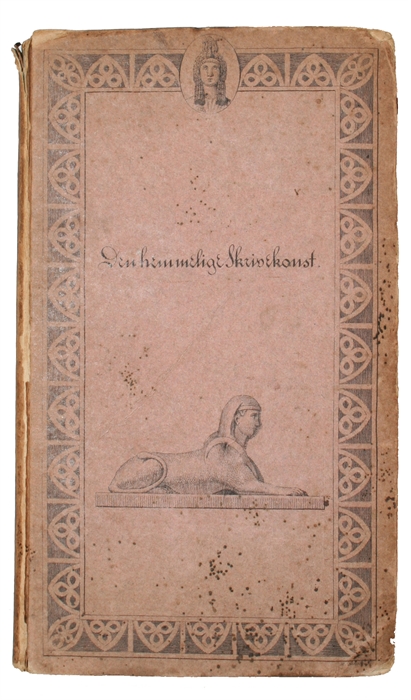THE VIGENÈRE CIPHER CORRECTLY DESCRIBED FOR THE FIRST TIME
LINDENFELS, I.B.
Den hemmelige Skrivekonst eller: Chiffrer= og Dechiffrer=Konsten, isærdeleshed practiskt oplyst ved et nyt Transpositionschiffre, der formedelst dets utallige Afvexlinger, i Forening med den største Simpelhed og Lethed, kan gjøres aldeles uopløseligt, endog for den, som har opfundet det. Ledsaget af en Forerindring, en Indledning og et Tillæg. Med otte Kobbertavler og mange Tabeller. "Ei blot til Lyst." [i.e. The Secret Art of Writing, or: The Art of Ciphering and Deciphering...].
Kjøvenhavn [Copenhagen], Brummers Forlag, 1819. 8vo. In the fragile and rare original engraved paper-binding with wear and bumping to capitals and corners, but overall fine. Spine a bit soiled and some minor ink-spotting to front board. Internally some occasional brownspotting, but overall nice and clean. Half-title, engraved title-page, (being pp. 1-4), XL pp. + pp. (5) - 294 + 1 leaf errata + 9 engraved plates (numbered I-IX, though the title-page states "eight engraved plates") + 5 folded tables (in all there are 7 tables that are numbered, namely A(a-c)-E, of which Ab+c,C,D,E are folded, Aa-B are in the text and are 3/4 and almost full-page respectively. Table D has a tear, no loss).Printed on good, heavy paper.
Orig. koberstukket kartonnage, hvor ryggen dog er slidt. Hjørner stødte. Kobberstukket titelblad, XL,294, pp. + 1 blad errata + talrige foldetabeller og 9 kobberstukne foldeplancher. Trykt på skrivepapir, men her og der noget brunplettet.
The rare first printing of this highly important work of cryptography, which is the very first work to correctly describe Vigenère's cipher. "Lindenfels, so far as I can ascertain, is the only writer who accurately presents both the tables and the directions of Vigenère." (Charles J. Mendelsohn, 1940). The present work also constitutes the first Danish cryptographical work.
"All European countries have a larger or smaller collection of crytographical works in their languages, whereas we in Denmark, as far as the author is aware, do not own a single letter thereof in the mother tongue. The author has therefore endeavoured, also in a scientific sense, not to be entirely unworthy in filling out this lacuna in the national literature. Both of these purposes unite in the "pium desiderum": to enable our young officials - in particular the military - to match also in this respect those of our neighbouring nations. It is necessary in times such as ours, not to lag behind foreigners, especially in these things, if we do not wish at all hours to succumb to them." (from the "Prereminder" - translated from Danish in Franksen).
"In 1918, Charles J. Mendelsohn was made a captain in the Military Intelligence Division of the General Staff of the U.S. Army, in charge of decipherment of German codes. A classic scholar and faculty member of the history department in the College of the City of New York, he was launched by his experience into a lifelong study of historical ciphers and their originators. Among other things, this research resulted in two fundamental papers on Cardano and de Vigenère, respectively... With this background in mind we are hard put to find a more authoritative source on the history of the Vigenère cipher than the article by Mendelsohn. It is therefore noteworthy to read in Mendelsohn's abstract, that "In all the literature of cipher, I know of only one writer who has correctly described Vigenère's cipher, and that was well over one hundred years ago." In the body of the article Mendelsohn, referring to "I.B. Lindenfels, Den hemmelige Skrivekonst (Copenhagen, 1819)", expands on this remark... (see first quotation above). On this authority I have often relied on Lindenfels' work for factual information in past discussions. Yet, I have withheld his story which, lying dormant in the Danish Army Archives and some contemporary bibliographical accounts, is perhaps as fascinating as the topic he describes... Its title page was engraved, so Lindenfels proudly tells us, together with nine other illustrations by a young artist, H.C. Klingsey, employed as a map-maker by the Danish navy. It reveals that Lindenfels was a major of the artillery and a teacher of the Royal Pageans (cadets training for general staff and military engineering), at the Land Cadet Academy (infantry and horse), and at the Artillery Cadet Institute... In the "prereminder", Lindenfels assures the reader that he has done everything in his power to make the book as entertaining as possible. Simultaneously, however, he emphasizes that his choice of motto "Ei blot til lyst" (not only for pleasure) on the title-page, is made on purpose (see quotation from the Prereminder above)..." (Franksen, pp. 215-17).
Lindenfels does not invent or introduce an entirely new cipher, he does, however, in the present work, introduce a new practice that is to replace the simple substitution cipher or traditional nomenclature, and in fact he becomes the first to describe the seminal Vigenère cipher correctly.
The work is divided into three parts, namely Simple substitution ciphers and nomenclatures; the Vigenère cipher; and a Supplement, all of about the same length. The supplement not only describes the history of ciphers and codes but also covers sign languages, both of thieves and deaf and mutes.
Being the first such work in the Danish language, of course it arose some curiosity and excitement. It is evident from the subscription list that Kind Fredrik VI himself purchased 10 copies alone.
For curiosity it can be mentioned that Lindenfels here mentions "the newest galvanic and electric discoveries" and "the incredible bordering progress in physics and chemistry", referring to Ørsted and inferring how Ørsted gradually worked towards his discovery of electromagnetism in 1820, about a year after Lindenfels had published his work.
For a long and thorough description of the work and of Lindenfels, see:
Franksen, Mr. Babbage's Secret. The Tale of a Cypher - and APL. (IBM).
Order-nr.: 42688

